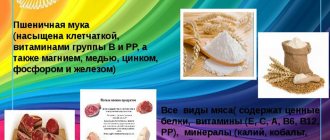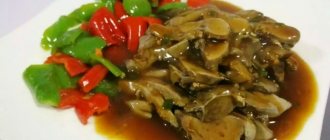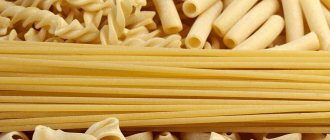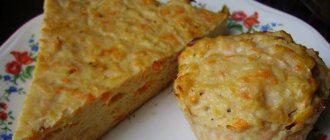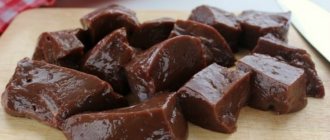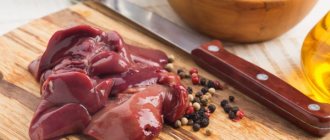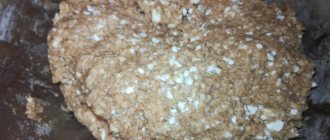Calorie content of boiled chicken necks. Chemical composition and nutritional value.
Nutritional value and chemical composition of “boiled chicken necks”.
The table shows the nutritional content (calories, proteins, fats, carbohydrates, vitamins and minerals) per 100 grams of edible portion.
| Nutrient | Quantity | Norm** | % of the norm in 100 g | % of the norm in 100 kcal | 100% normal |
| Calorie content | 175.33 kcal | 1684 kcal | 10.4% | 5.9% | 960 g |
| Squirrels | 20.85 g | 76 g | 27.4% | 15.6% | 365 g |
| Fats | 10 g | 56 g | 17.9% | 10.2% | 560 g |
The energy value of boiled chicken necks is 175.33 kcal.
Primary Source: Created in the application by the user. Read more.
** This table shows the average levels of vitamins and minerals for an adult. If you want to know the norms taking into account your gender, age and other factors, then use the “My Healthy Diet” application.
Calorie content of chicken necks. Chemical composition and nutritional value.
Nutritional value and chemical composition of “chicken necks”.
The table shows the nutritional content (calories, proteins, fats, carbohydrates, vitamins and minerals) per 100 grams of edible portion.
| Nutrient | Quantity | Norm** | % of the norm in 100 g | % of the norm in 100 kcal | 100% normal |
| Calorie content | 297 kcal | 1684 kcal | 17.6% | 5.9% | 567 g |
| Squirrels | 14.07 | 76 g | 18.5% | 6.2% | 540 g |
| Fats | 26.24 g | 56 g | 46.9% | 15.8% | 213 g |
The energy value of chicken necks is 297 kcal.
Primary Source: Created in the application by the user. Read more.
** This table shows the average levels of vitamins and minerals for an adult. If you want to know the norms taking into account your gender, age and other factors, then use the “My Healthy Diet” application.
Calorie content of Chicken necks. Chemical composition and nutritional value.
Nutritional value and chemical composition of “Chicken necks”.
The table shows the nutritional content (calories, proteins, fats, carbohydrates, vitamins and minerals) per 100 grams of edible portion.
| Nutrient | Quantity | Norm** | % of the norm in 100 g | % of the norm in 100 kcal | 100% normal |
| Calorie content | 182 kcal | 1684 kcal | 10.8% | 5.9% | 925 g |
| Squirrels | 18.7 g | 76 g | 24.6% | 13.5% | 406 g |
| Fats | 11.4 g | 56 g | 20.4% | 11.2% | 491 g |
| Carbohydrates | 0.2 g | 219 g | 0.1% | 0.1% | 109500 g |
The energy value of Chicken necks is 182 kcal.
Primary Source: Created in the application by the user. Read more.
** This table shows the average levels of vitamins and minerals for an adult. If you want to know the norms taking into account your gender, age and other factors, then use the “My Healthy Diet” application.
How you cook chicken matters
Chicken meat alone contains relatively low amounts of calories and fat compared to other meats. But once you start adding butter, sauce, batter and breading, the calories start adding up.
For example, a cooked skinless, boneless chicken thigh (52 grams) contains 109 calories and 5.7 grams of fat (2).
But the same battered chicken thigh contains 144 calories and 8.6 grams of fat. A chicken thigh fried in a flour coating contains even more, with 162 calories and 9.3 grams of fat (11, 12).
Similarly, one cooked boneless, skinless chicken wing (21 grams) contains 43 calories and 1.7 grams of fat (3).
However, a chicken wing baked in barbecue sauce contains 61 calories and 3.7 grams of fat. This compares to a wing fried in a flour coating, which contains 61 calories and 4.2 grams of fat (13, 14).
Therefore, cooking methods that add a little fat, such as boiling, sautéing, frying, grilling and steaming, are the best choices for keeping calorie levels low.
Cooking techniques such as breading and coating the meat in sauce can add more than a few calories to your chicken. For the ultimate low-calorie version of chicken, you can boil, grill, stew, or steam it.
Calories in chicken neck. Chemical composition and nutritional value.
Nutritional value and chemical composition of “chicken neck”.
The table shows the nutritional content (calories, proteins, fats, carbohydrates, vitamins and minerals) per 100 grams of edible portion.
| Nutrient | Quantity | Norm** | % of the norm in 100 g | % of the norm in 100 kcal | 100% normal |
| Calorie content | 181 kcal | 1684 kcal | 10.7% | 5.9% | 930 g |
| Squirrels | 16.5 g | 76 g | 21.7% | 12% | 461 g |
| Fats | 12.6 g | 56 g | 22.5% | 12.4% | 444 g |
The energy value of chicken neck is 181 kcal.
Primary Source: Created in the application by the user. Read more.
** This table shows the average levels of vitamins and minerals for an adult. If you want to know the norms taking into account your gender, age and other factors, then use the “My Healthy Diet” application.
How much kebab can you eat while on a healthy diet?
Any meal should consist of vegetables, meat or other protein, as well as carbohydrates and fats. A regular portion of meat when eating should be the size of a palm without fingers, this is no more than 70 grams. However, if you go out into nature and spend active recreation, then you can double this portion without a twinge of conscience. At the same time, watch what you eat besides meat. Eat more vegetables and less potatoes. Don’t eat everything at once, spread out the portion over a fairly long period of time. Don't be afraid to gain weight, and most importantly, don't step on the scale the next day.
Calorie content of chicken necks. Chemical composition and nutritional value.
chicken necks
are rich in vitamins and minerals such as: choline - 15.2%, vitamin B5 - 15.2%, vitamin B6 - 26%, vitamin B12 - 18.3%, vitamin H - 20%, vitamin PP - 62, 5%, phosphorus - 20.6%, cobalt - 120%, chromium - 18%, zinc - 17.2%
- Choline
is part of lecithin, plays a role in the synthesis and metabolism of phospholipids in the liver, is a source of free methyl groups, and acts as a lipotropic factor. - Vitamin B5
is involved in protein, fat, carbohydrate metabolism, cholesterol metabolism, the synthesis of a number of hormones, hemoglobin, promotes the absorption of amino acids and sugars in the intestines, and supports the function of the adrenal cortex. A lack of pantothenic acid can lead to damage to the skin and mucous membranes. - Vitamin B6
is involved in maintaining the immune response, processes of inhibition and excitation in the central nervous system, in the transformation of amino acids, the metabolism of tryptophan, lipids and nucleic acids, promotes the normal formation of red blood cells, and maintaining normal levels of homocysteine in the blood. Insufficient intake of vitamin B6 is accompanied by decreased appetite, impaired skin condition, and the development of homocysteinemia and anemia. - Vitamin B12
plays an important role in the metabolism and transformation of amino acids. Folate and vitamin B12 are interconnected vitamins that are involved in hematopoiesis. A lack of vitamin B12 leads to the development of partial or secondary folate deficiency, as well as anemia, leukopenia, and thrombocytopenia. - Vitamin H
is involved in the synthesis of fats, glycogen, and amino acid metabolism. Insufficient consumption of this vitamin can lead to disruption of the normal condition of the skin. - Vitamin PP
is involved in redox reactions of energy metabolism. Insufficient vitamin intake is accompanied by disruption of the normal condition of the skin, gastrointestinal tract and nervous system. - Phosphorus
takes part in many physiological processes, including energy metabolism, regulates acid-base balance, is part of phospholipids, nucleotides and nucleic acids, and is necessary for the mineralization of bones and teeth. Deficiency leads to anorexia, anemia, and rickets. - Cobalt
is part of vitamin B12. Activates enzymes of fatty acid metabolism and folic acid metabolism. - Chromium
is involved in the regulation of blood glucose levels, enhancing the effect of insulin. Deficiency leads to decreased glucose tolerance. - Zinc
is part of more than 300 enzymes and is involved in the processes of synthesis and breakdown of carbohydrates, proteins, fats, nucleic acids and in the regulation of the expression of a number of genes. Insufficient consumption leads to anemia, secondary immunodeficiency, liver cirrhosis, sexual dysfunction, and the presence of fetal malformations. Research in recent years has revealed the ability of high doses of zinc to disrupt the absorption of copper and thereby contribute to the development of anemia.
morehide
You can view a complete directory of the healthiest foods in the “My Healthy Diet” app.
The benefits and harms of chicken
Nutritionists recommend consuming domestic chicken, since artificially bred birds are often raised with hormones and treated with antibiotics. Among all the methods of preparing chicken, preference is best given to boiling, steaming, stewing or baking, but in no case frying. The fact is that during frying, protein molecules are damaged, the amount of fat increases, and carcinogens are released.
Photo source: shutterstock.com
It is also not recommended to eat smoked chicken, since, in addition to natural smoking, there is another way to obtain this tasty meat - chemical processing, during which phenols and carcinogens are formed.
Calorie content Boiled chicken necks. Chemical composition and nutritional value.
Nutritional value and chemical composition of “Boiled chicken necks”.
The table shows the nutritional content (calories, proteins, fats, carbohydrates, vitamins and minerals) per 100 grams of edible portion.
| Nutrient | Quantity | Norm** | % of the norm in 100 g | % of the norm in 100 kcal | 100% normal |
| Calorie content | 236.17 kcal | 1684 kcal | 14% | 5.9% | 713 g |
| Squirrels | 17.46 g | 76 g | 23% | 9.7% | 435 g |
| Fats | 18.12 g | 56 g | 32.4% | 13.7% | 309 g |
The energy value of boiled chicken necks is 236.17 kcal.
Primary Source: Created in the application by the user. Read more.
** This table shows the average levels of vitamins and minerals for an adult. If you want to know the norms taking into account your gender, age and other factors, then use the “My Healthy Diet” application.
Calorie content Boiled chicken necks without skin. Chemical composition and nutritional value.
Nutritional value and chemical composition of “Boiled chicken necks without skin.”
The table shows the nutritional content (calories, proteins, fats, carbohydrates, vitamins and minerals) per 100 grams of edible portion.
| Nutrient | Quantity | Norm** | % of the norm in 100 g | % of the norm in 100 kcal | 100% normal |
| Calorie content | 218.117 kcal | 1684 kcal | 13% | 6% | 772 g |
| Squirrels | 10 g | 76 g | 13.2% | 6.1% | 760 g |
| Fats | 12 g | 56 g | 21.4% | 9.8% | 467 g |
The energy value of boiled skinless chicken necks is 218.117 kcal.
Primary Source: Created in the application by the user. Read more.
** This table shows the average levels of vitamins and minerals for an adult. If you want to know the norms taking into account your gender, age and other factors, then use the “My Healthy Diet” application.
Chicken calorie content, beneficial properties
Calorie content of individual chicken parts
Chicken carcass parts are not uniform in calorie content. In ascending order, the caloric content of individual parts is as follows:
- calorie content of chicken breast (fillet) – 115 kcal per 100g;
- calorie content of chicken legs – 1 60–190 kcal per 100g;
- calorie content of chicken thigh – 1 80–210 kcal per 100g;
- calorie content of chicken wings – 1 80–190 kcal per 100g.
Calorie content of chicken necks. Chemical composition and nutritional value.
Nutritional value and chemical composition of “chicken necks”.
The table shows the nutritional content (calories, proteins, fats, carbohydrates, vitamins and minerals) per 100 grams of edible portion.
| Nutrient | Quantity | Norm** | % of the norm in 100 g | % of the norm in 100 kcal | 100% normal |
| Calorie content | 124 kcal | 1684 kcal | 7.4% | 6% | 1358 g |
| Squirrels | 5 g | 76 g | 6.6% | 5.3% | 1520 g |
| Fats | 10 g | 56 g | 17.9% | 14.4% | 560 g |
The energy value of chicken necks is 124 kcal.
Primary Source: Created in the application by the user. Read more.
** This table shows the average levels of vitamins and minerals for an adult. If you want to know the norms taking into account your gender, age and other factors, then use the “My Healthy Diet” application.
Vitamins in Chicken necks
Chicken necks contain the following vitamins: SFA - Saturated fatty acids, Cholesterol, Ash, Water, Sodium, Potassium, Phosphorus, Magnesium, Calcium, Copper, Manganese, Selenium, Zinc, Iron.
Chicken is a popular option when it comes to lean protein, as it contains a significant amount of it per serving without excess fat. It is also easy to prepare at home and is served in most restaurants. Chicken dishes can be found on almost any menu, no matter what country you are trying.
But you may be wondering how many calories are in that chicken on your plate.
People eat various parts of chicken, including chicken breast, thighs, wings, and drumsticks. Each part contains a different number of calories and different proportions of protein and fat.
Here are the calories for the most popular parts of chicken.

How many calories are in chicken breast, thighs, wings and drumsticks?
Calorie content of Chicken necks. Chemical composition and nutritional value.
Nutritional value and chemical composition of “Chicken necks”.
The table shows the nutritional content (calories, proteins, fats, carbohydrates, vitamins and minerals) per 100 grams of edible portion.
| Nutrient | Quantity | Norm** | % of the norm in 100 g | % of the norm in 100 kcal | 100% normal |
| Calorie content | 297 kcal | 1684 kcal | 17.6% | 5.9% | 567 g |
| Squirrels | 14.07 | 76 g | 18.5% | 6.2% | 540 g |
| Fats | 26.24 g | 56 g | 46.9% | 15.8% | 213 g |
The energy value of Chicken necks is 297 kcal.
Primary Source: Created in the application by the user. Read more.
** This table shows the average levels of vitamins and minerals for an adult. If you want to know the norms taking into account your gender, age and other factors, then use the “My Healthy Diet” application.
Chicken necks recipe. Calorie, chemical composition and nutritional value.
| Nutrient | Quantity | Norm** | % of the norm in 100 g | % of the norm in 100 kcal | 100% normal |
| Calorie content | 139.4 kcal | 1684 kcal | 8.3% | 6% | 1208 g |
| Squirrels | 11.3 g | 76 g | 14.9% | 10.7% | 673 g |
| Fats | 8.9 g | 56 g | 15.9% | 11.4% | 629 g |
| Carbohydrates | 2.6 g | 219 g | 1.2% | 0.9% | 8423 g |
| Organic acids | 0.1 g | ~ | |||
| Alimentary fiber | 0.8 g | 20 g | 4% | 2.9% | 2500 g |
| Water | 189 g | 2273 g | 8.3% | 6% | 1203 g |
| Ash | 0.773 g | ~ | |||
| Vitamins | |||||
| Vitamin A, RE | 180 mcg | 900 mcg | 20% | 14.3% | 500 g |
| Retinol | 0.027 mg | ~ | |||
| beta carotene | 0.917 mg | 5 mg | 18.3% | 13.1% | 545 g |
| Vitamin B1, thiamine | 0.05 mg | 1.5 mg | 3.3% | 2.4% | 3000 g |
| Vitamin B2, riboflavin | 0.151 mg | 1.8 mg | 8.4% | 6% | 1192 g |
| Vitamin B5, pantothenic | 0.712 mg | 5 mg | 14.2% | 10.2% | 702 g |
| Vitamin B6, pyridoxine | 0.214 mg | 2 mg | 10.7% | 7.7% | 935 g |
| Vitamin B9, folates | 7.508 mcg | 400 mcg | 1.9% | 1.4% | 5328 g |
| Vitamin B12, cobalamin | 0.197 mcg | 3 mcg | 6.6% | 4.7% | 1523 g |
| Vitamin C, ascorbic acid | 2.8 mg | 90 mg | 3.1% | 2.2% | 3214 g |
| Vitamin E, alpha tocopherol, TE | 1.617 mg | 15 mg | 10.8% | 7.7% | 928 g |
| Vitamin H, biotin | 0.236 mcg | 50 mcg | 0.5% | 0.4% | 21186 g |
| Vitamin K, phylloquinone | 1 mcg | 120 mcg | 0.8% | 0.6% | 12000 g |
| Vitamin RR, NE | 2.7613 mg | 20 mg | 13.8% | 9.9% | 724 g |
| Niacin | 0.132 mg | ~ | |||
| Macronutrients | |||||
| Potassium, K | 181.46 mg | 2500 mg | 7.3% | 5.2% | 1378 g |
| Calcium, Ca | 26.7 mg | 1000 mg | 2.7% | 1.9% | 3745 g |
| Magnesium, Mg | 17.93 mg | 400 mg | 4.5% | 3.2% | 2231 g |
| Sodium, Na | 52.77 mg | 1300 mg | 4.1% | 2.9% | 2464 g |
| Sera, S | 14.05 mg | 1000 mg | 1.4% | 1% | 7117 g |
| Phosphorus, Ph | 88.4 mg | 800 mg | 11.1% | 8% | 905 g |
| Chlorine, Cl | 5.59 mg | 2300 mg | 0.2% | 0.1% | 41145 g |
| Microelements | |||||
| Aluminium, Al | 109 mcg | ~ | |||
| Bor, B | 42.7 mcg | ~ | |||
| Iron, Fe | 1.557 mg | 18 mg | 8.7% | 6.2% | 1156 g |
| Yod, I | 0.64 mcg | 150 mcg | 0.4% | 0.3% | 23438 g |
| Cobalt, Co | 1.067 mcg | 10 mcg | 10.7% | 7.7% | 937 g |
| Lithium, Li | 0.44 mcg | ~ | |||
| Manganese, Mn | 0.0709 mg | 2 mg | 3.5% | 2.5% | 2821 g |
| Copper, Cu | 86.45 mcg | 1000 mcg | 8.6% | 6.2% | 1157 g |
| Nickel, Ni | 0.64 mcg | ~ | |||
| Rubidium, Rb | 101.5 mcg | ~ | |||
| Selenium, Se | 8.323 mcg | 55 mcg | 15.1% | 10.8% | 661 g |
| Fluorine, F | 24.88 mcg | 4000 mcg | 0.6% | 0.4% | 16077 g |
| Chromium, Cr | 0.43 mcg | 50 mcg | 0.9% | 0.6% | 11628 g |
| Zinc, Zn | 1.8322 mg | 12 mg | 15.3% | 11% | 655 g |
| Digestible carbohydrates | |||||
| Starch and dextrins | 0.055 g | ~ | |||
| Mono- and disaccharides (sugars) | 2.6 g | max 100 g | |||
| Glucose (dextrose) | 0.461 g | ~ | |||
| Sucrose | 1.643 g | ~ | |||
| Fructose | 0.329 g | ~ | |||
| Essential amino acids | 0.084 g | ~ | |||
| Arginine* | 0.689 g | ~ | |||
| Valin | 0.544 g | ~ | |||
| Histidine* | 0.34 g | ~ | |||
| Isoleucine | 0.582 g | ~ | |||
| Leucine | 0.825 g | ~ | |||
| Lysine | 0.934 g | ~ | |||
| Methionine | 0.302 g | ~ | |||
| Methionine + Cysteine | 0.006 g | ~ | |||
| Threonine | 0.467 g | ~ | |||
| Tryptophan | 0.131 g | ~ | |||
| Phenylalanine | 0.44 g | ~ | |||
| Phenylalanine+Tyrosine | 0.019 g | ~ | |||
| Nonessential amino acids | 0.185 g | ~ | |||
| Alanin | 0.605 g | ~ | |||
| Aspartic acid | 0.988 g | ~ | |||
| Glycine | 0.542 g | ~ | |||
| Glutamic acid | 1.682 g | ~ | |||
| Proline | 0.453 g | ~ | |||
| Serin | 0.38 g | ~ | |||
| Tyrosine | 0.372 g | ~ | |||
| Cysteine | 0.142 g | ~ | |||
| Sterols (sterols) | |||||
| Cholesterol | 51.13 mg | max 300 mg | |||
| beta sitosterol | 6.933 mg | ~ | |||
| Saturated fatty acids | |||||
| Saturated fatty acids | 1.8 g | max 18.7 g | |||
| 12:0 Lauric | 0.025 g | ~ | |||
| 14:0 Miristinovaya | 0.031 g | ~ | |||
| 16:0 Palmitinaya | 1.139 g | ~ | |||
| 18:0 Stearic | 0.506 g | ~ | |||
| 20:0 Arakhinovaya | 0.01 g | ~ | |||
| 22:0 Begenovaya | 0.024 g | ~ | |||
| Monounsaturated fatty acids | 2.507 g | min 16.8 g | 14.9% | 10.7% | |
| 16:1 Palmitoleic | 0.246 g | ~ | |||
| 18:1 Oleic (omega-9) | 2.22 g | ~ | |||
| 20:1 Gadoleic (omega-9) | 0.012 g | ~ | |||
| Polyunsaturated fatty acids | 3.416 g | from 11.2 to 20.6 g | 30.5% | 21.9% | |
| 18:2 Linolevaya | 3.102 g | ~ | |||
| 18:3 Linolenic | 0.043 g | ~ | |||
| 20:4 Arachidonic | 0.129 g | ~ | |||
| 20:5 Eicosapentaenoic acid (EPA), Omega-3 | 0.012 g | ~ | |||
| Omega-3 fatty acids | 0.1 g | from 0.9 to 3.7 g | 11.1% | 8% | |
| 22:5 Docosapentaenoic acid (DPA), Omega-3 | 0.025 g | ~ | |||
| 22:6 Docosahexaenoic acid (DHA), Omega-3 | 0.049 g | ~ | |||
| Omega-6 fatty acids | 1.2 g | from 4.7 to 16.8 g | 25.5% | 18.3% |
Micro- and macroelements in Chicken necks
Chicken necks contain the following elements: SFA - Saturated fatty acids, Cholesterol, Ash, Water, Sodium, Potassium, Phosphorus, Magnesium, Calcium, Copper, Manganese, Selenium, Zinc, Iron.
| Micro and macro element | Meaning |
| SFA - Saturated fatty acids, g. | 7,27 |
| Cholesterol, mg | 99 |
| Zola, Mr. | 0,55 |
| Water, city | 59,99 |
| Sodium, mg | 64 |
| Potassium, mg | 137 |
| Phosphorus, mg | 112 |
| Magnesium, mg | 13 |
| Calcium, mg | 18 |
| Copper, µg | 80 |
| Manganese, mg | 0,033 |
| Selenium, mcg | 12 |
| Zinc, mg | 1,86 |
| Iron, mg | 1,9 |
Calorie content of Chicken necks. Chemical composition and nutritional value.
Nutritional value and chemical composition of “Chicken necks”.
The table shows the nutritional content (calories, proteins, fats, carbohydrates, vitamins and minerals) per 100 grams of edible portion.
| Nutrient | Quantity | Norm** | % of the norm in 100 g | % of the norm in 100 kcal | 100% normal |
| Calorie content | 298 kcal | 1684 kcal | 17.7% | 5.9% | 565 g |
| Squirrels | 16.7 g | 76 g | 22% | 7.4% | 455 g |
| Fats | 26.24 g | 56 g | 46.9% | 15.7% | 213 g |
The energy value of Chicken necks is 298 kcal.
Primary Source: Created in the application by the user. Read more.
** This table shows the average levels of vitamins and minerals for an adult. If you want to know the norms taking into account your gender, age and other factors, then use the “My Healthy Diet” application.
Chicken meat in dietetics and for weight loss
Chicken is one of the best sources of protein and is also suitable for any diet that requires a source of lean meat and protein.
In particular, chicken fillet has beneficial properties. Protein diets are known to be effective in weight loss. Chicken is the main assistant in weight loss, since the meat provides high protein content. Studies and trials have shown that significant weight control has been observed in those people who eat chicken regularly. Proteins in chicken meat help:
- muscle growth and development;
- maintain a healthy body weight;
- lose weight.

